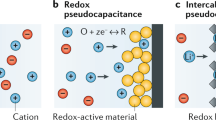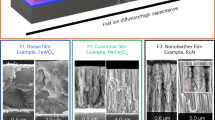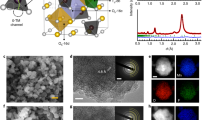Abstract
Rapid charge and discharge rates have become an important feature of electrical energy storage devices, but cause dramatic reductions in the energy that can be stored or delivered by most rechargeable batteries (their energy capacity)1,2,3,4,5,6,7. Supercapacitors do not suffer from this problem, but are restricted to much lower stored energy per mass (energy density) than batteries8. A storage technology that combines the rate performance of supercapacitors with the energy density of batteries would significantly advance portable and distributed power technology2. Here, we demonstrate very large battery charge and discharge rates with minimal capacity loss by using cathodes made from a self-assembled three-dimensional bicontinuous nanoarchitecture consisting of an electrolytically active material sandwiched between rapid ion and electron transport pathways. Rates of up to 400C and 1,000C for lithium-ion and nickel-metal hydride chemistries, respectively, are achieved (where a 1C rate represents a one-hour complete charge or discharge), enabling fabrication of a lithium-ion battery that can be 90% charged in 2 minutes.
This is a preview of subscription content, access via your institution
Access options
Subscribe to this journal
Receive 12 print issues and online access
$259.00 per year
only $21.58 per issue
Buy this article
- Purchase on Springer Link
- Instant access to full article PDF
Prices may be subject to local taxes which are calculated during checkout





Similar content being viewed by others
References
Taberna, L., Mitra, S., Poizot, P., Simon, P. & Tarascon, J. M. High rate capabilities Fe3O4-based Cu nano-architectured electrodes for lithium-ion battery applications. Nature Mater. 5, 567–573 (2006).
Kang, B. & Ceder, G. Battery materials for ultrafast charging and discharging. Nature 458, 190–193 (2009).
Chung, S. Y., Bloking, J. T. & Chiang, Y. M. Electronically conductive phospho-olivines as lithium storage electrodes. Nature Mater. 1, 123–128 (2002).
Yao, M. et al. Nickel substrate having three-dimensional micronetwork structure for high-power nickel/metal-hydride battery. Electrochem. Solid State Lett. 10, A56–A59 (2007).
Bruce, P. G., Scrosati, B. & Tarascon, J. M. Nanomaterials for rechargeable lithium batteries. Angew. Chem. Int. Ed. 47, 2930–2946 (2008).
Kang, K. S., Meng, Y. S., Breger, J., Grey, C. P. & Ceder, G. Electrodes with high power and high capacity for rechargeable lithium batteries. Science 311, 977–980 (2006).
Rolison, D. R. et al. Multifunctional 3D nanoarchitectures for energy storage and conversion. Chem. Soc. Rev. 38, 226–252 (2009).
Arico, A. S., Bruce, P., Scrosati, B., Tarascon, J. M. & Van Schalkwijk, W. Nanostructured materials for advanced energy conversion and storage devices. Nature Mater. 4, 366–377 (2005).
Wang, Y. G., Wang, Y. R., Hosono, E. J., Wang, K. X. & Zhou, H. S. The design of a LiFePO4/carbon nanocomposite with a core–shell structure and its synthesis by an in situ polymerization restriction method. Angew. Chem. Int. Ed. 47, 7461–7465 (2008).
Doherty, C. M., Caruso, R. A., Smarsly, B. M., Adelhelm, P. & Drummond, C. J. Hierarchically porous monolithic LiFePO4/carbon composite electrode materials for high power lithium ion batteries. Chem. Mater. 21, 5300–5306 (2009).
Cui, L. F., Yang, Y., Hsu, C. M. & Cui, Y. Carbon-silicon core-shell nanowires as high capacity electrode for lithium ion batteries. Nano Lett. 9, 3370–3374 (2009).
Long, J. W., Dunn, B., Rolison, D. R. & White, H. S. Three-dimensional battery architectures. Chem. Rev. 104, 4463–4492 (2004).
Whitehead, A. H. & Schreiber, M. Current collectors for positive electrodes of lithium-based batteries. J. Electrochem. Soc. 152, A2105–A2113 (2005).
Yao, M., Okuno, K., Iwaki, T., Awazu, T. & Sakai, T. Long cycle-life LiFePO4/Cu–Sn lithium ion battery using foam-type three-dimensional current collector. J. Power Sources 195, 2077–2081 (2010).
Ripenbein, T., Golodnitsky, D., Nathan, M. & Peled, E. Electroless nickel current collector for 3D-microbatteries. J. Appl. Electrochem. 40, 435–444 (2010).
Plichta, E. et al. A rechargeable Li/LixCoO2 Cell. J. Power Sources 21, 25–31 (1987).
Shembel, E. M. et al. Problems of corrosion and other electrochemical side processes in lithium chemical power sources with non-aqueous electrolytes. J. Power Sources 54, 421–424 (1995).
Yao, M. et al. LiFePO4-based electrode using micro-porous current collector for high power lithium ion battery. J. Power Sources 173, 545–549 (2007).
Kim, J. H., Myung, S. T. & Sun, Y. K. Molten salt synthesis of LiNi0.5Mn1.5O4 spinel for 5 V class cathode material of Li-ion secondary battery. Electrochim. Acta 49, 219–227 (2004).
Guo, J. C. & Wang, C. S. A polymer scaffold binder structure for high capacity silicon anode of lithium-ion battery. Chem. Commun. 46, 1428–1430 (2010).
Reddy, A. L. M., Shaijumon, M. M., Gowda, S. R. & Ajayan, P. M. Coaxial MnO2/carbon nanotube array electrodes for high-performance lithium batteries. Nano Lett. 9, 1002–1006 (2009).
Lee, S. W. et al. High-power lithium batteries from functionalized carbon-nanotube electrodes. Nature Nanotech. 5, 531–537 (2010).
Fischer, A. E., Pettigrew, K. A., Rolison, D. R., Stroud, R. M. & Long, J. W. Incorporation of homogeneous, nanoscale MnO2 within ultraporous carbon structures via self-limiting electroless deposition: implications for electrochemical capacitors. Nano Lett. 7, 281–286 (2007).
Ergang, N. S. et al. Photonic crystal structures as a basis for a three-dimensionally interpenetrating electrochemical-cell system. Adv. Mater. 18, 1750–1753 (2006).
Ergang, N. S., Fierke, M. A., Wang, Z., Smyrl, W. H. & Stein, A. Fabrication of a fully infiltrated three-dimensional solid-state interpenetrating electrochemical cell. J. Electrochem. Soc. 154, A1135–A1139 (2007).
Wang, Z., Fierke, M. A. & Stein, A. Porous carbon/tin (IV) oxide monoliths as anodes for lithium-ion batteries. J. Electrochem. Soc. 155, A658–A663 (2008).
Ergang, N. S., Lytle, J. C., Yan, H. W. & Stein, A. Effect of a macropore structure on cycling rates of LiCoO2 . J. Electrochem. Soc. 152, A1989–A1995 (2005).
Sakamoto, J. S. & Dunn, B. Hierarchical battery electrodes based on inverted opal structures. J. Mater. Chem. 12, 2859–2861 (2002).
Stephenson, D. E., Hartman, E. M., Harb, J. N. & Wheeler, D. R. Modeling of particle–particle interactions in porous cathodes for lithium-ion batteries. J. Electrochem. Soc. 154, A1146–A1155 (2007).
Yu, X. D., Lee, Y. J., Furstenberg, R., White, J. O. & Braun, P. V. Filling fraction dependent properties of inverse opal metallic photonic crystals. Adv. Mater. 19, 1689–1692 (2007).
Wu, M. S., Huang, Y. A. & Yang, C. H. Capacitive behavior of porous nickel oxide/hydroxide electrodes with interconnected nanoflakes synthesized by anodic electrodeposition. J. Electrochem. Soc. 155, A798–A805 (2008).
Tench, D. & Warren, L. F. Electrodeposition of conducting transition-metal oxide hydroxide films from aqueous-solution. J. Electrochem. Soc. 130, 869–872 (1983).
Motupally, S., Streinz, C. C. & Weidner, J. W. Proton diffusion in nickel hydroxide—prediction of active material utilization. J. Electrochem. Soc. 145, 29–34 (1998).
Mao, Z., Devidts, P., White, R. E. & Newman, J. Theoretical analysis of the discharge performance of a NiOOH/H2 cell. J. Electrochem. Soc. 141, 54–63 (1994).
Corrigan, D. A. & Knight, S. L. Electrochemical and spectroscopic evidence on the participation of quadrivalent nickel in the nickel-hydroxide redox reaction. J. Electrochem. Soc. 136, 613–619 (1989).
Reimers, J. N., Fuller, E. W., Rossen, E. & Dahn, J. R. Synthesis and electrochemical studies of LiMnO2 prepared of low-temperatures. J. Electrochem. Soc. 140, 3396–3401 (1993).
Acknowledgements
This work was supported by the US Department of Energy, Division of Materials Sciences (DE-FG02-07ER46471) through the Materials Research Laboratory at the University of Illinois at Urbana-Champaign (energy storage studies), and the US Army Research Laboratory and US Army Research Office (DAAD19-03-1-0227) (three-dimensional electrode fabrication).
Author information
Authors and Affiliations
Contributions
H.Z., X.Y. and P.V.B. designed the experiments. H.Z and X.Y. performed and analysed the experiments. H.Z., X.Y. and P.V.B. wrote the manuscript. P.V.B. supervised the project.
Corresponding author
Ethics declarations
Competing interests
The authors declare no competing financial interests.
Supplementary information
Supplementary information
Supplementary information (PDF 1493 kb)
Rights and permissions
About this article
Cite this article
Zhang, H., Yu, X. & Braun, P. Three-dimensional bicontinuous ultrafast-charge and -discharge bulk battery electrodes. Nature Nanotech 6, 277–281 (2011). https://doi.org/10.1038/nnano.2011.38
Received:
Accepted:
Published:
Issue Date:
DOI: https://doi.org/10.1038/nnano.2011.38
This article is cited by
-
Preparation of Manganese Dioxide Supercapacitors by Secondary Construction of Three-Dimensional Substrates and Ion Embedding
Electronic Materials Letters (2022)
-
Ultra-high-energy lithium-ion batteries enabled by aligned structured thick electrode design
Rare Metals (2022)
-
Free-standing and binder-free porous monolithic electrodes prepared via sol–gel processes
Journal of Sol-Gel Science and Technology (2022)
-
Electrospun deposited Mn2O3/GO nanofiber composite electrode for hybrid coin cell supercapacitor devices
Journal of Materials Science: Materials in Electronics (2022)
-
The Non-local Effects Induced by Rapid Transient Mass Diffusion in a Spherical Silicon Electrode of Lithium-ion Batteries
Acta Mechanica Solida Sinica (2022)



